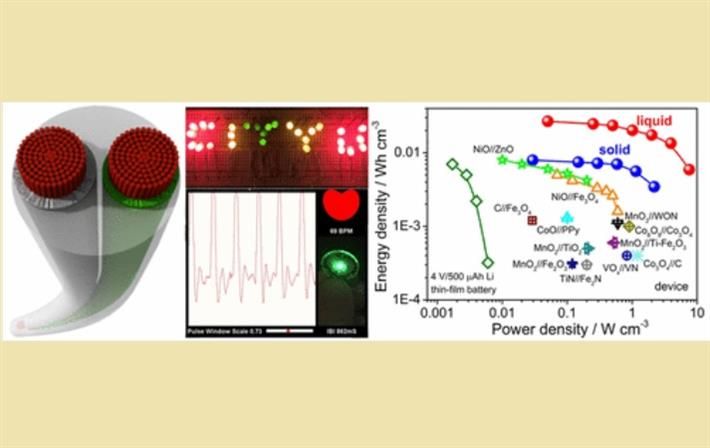Interviews
Chinese scientists develop yarn based battery
25 Aug '17
3 min read

Courtesy: ACS Nano/American Chemical Society
Removing the need for rigid and cumbersome batteries, Chinese researchers have designed a rechargeable and flexible yarn-based battery that could be produced at scale on existing industrial knitting or weaving machines. The multiple yarn batteries were tested assembled in series and in parallel to yield a higher current, showing excellent scalability.
The researchers have applied for patents and are hope to commercialise the new battery concept.
Their paper "Weavable, Conductive Yarn-Based NiCo//Zn Textile Battery with High Energy Density and Rate Capability" has been recently published in the ACS Nano journal. It reports an intrinsically safe textile battery composed of pairs of stainless steel yarns electrodeposited with zinc for the anode and nickel cobalt hydroxide for the cathode, jointly coated with a poly(vinyl alcohol)-based gel electrolyte.
The researchers used stainless steel spun at high temperature to form micron-sized filaments, followed by a twist-bundle drawing technique, obtaining highly conductive continuous yarns (180 to 250 micrometre in diameter) with a flexibility similar to that of cotton yarns. Those formed the basis for the two electrodes used in their yarn batteries.
Using industrial-grade knitting and weaving machines, the researchers demonstrated the dual (anode and cathode) yarns withstood well the conversion to highly conductive textiles.
For their conductive yarn-based textile battery, the researchers reported a high specific capacity, energy densities and power densities, based on the solid battery. The values were superior to most aqueous batteries and supercapacitors, claim the researchers.
The researchers also submitted their yarn battery to a series of deformation tests - straight, bent 95 degrees, twisted 360 degrees, and again straight, revealing that the charge curves almost overlap completely, and discharge curves as well as capacities do not change much at various deformation states.
Though cycling tests at different deformation states induced a slight capacity loss, the researchers attributed this capacity loss to the formation of crack on the electrode materials (being metal oxides). As well as being easy to mass produce and weave, multiple yarn batteries were tested assembled in series (for a higher voltage) and in parallel to yield a higher current, showing excellent scalability.
To prove their textile battery concept, the researchers fabricated a wrist band battery made out of a large conductive cloth, connecting four textile batteries in series for a 4.8 to 8 Volt operating window. The wrist band battery was able to power various electronic devices including a watch, a set of light emitting diodes, and a pulse sensor. (SV)
The researchers have applied for patents and are hope to commercialise the new battery concept.
Their paper "Weavable, Conductive Yarn-Based NiCo//Zn Textile Battery with High Energy Density and Rate Capability" has been recently published in the ACS Nano journal. It reports an intrinsically safe textile battery composed of pairs of stainless steel yarns electrodeposited with zinc for the anode and nickel cobalt hydroxide for the cathode, jointly coated with a poly(vinyl alcohol)-based gel electrolyte.
The researchers used stainless steel spun at high temperature to form micron-sized filaments, followed by a twist-bundle drawing technique, obtaining highly conductive continuous yarns (180 to 250 micrometre in diameter) with a flexibility similar to that of cotton yarns. Those formed the basis for the two electrodes used in their yarn batteries.
Using industrial-grade knitting and weaving machines, the researchers demonstrated the dual (anode and cathode) yarns withstood well the conversion to highly conductive textiles.
For their conductive yarn-based textile battery, the researchers reported a high specific capacity, energy densities and power densities, based on the solid battery. The values were superior to most aqueous batteries and supercapacitors, claim the researchers.
The researchers also submitted their yarn battery to a series of deformation tests - straight, bent 95 degrees, twisted 360 degrees, and again straight, revealing that the charge curves almost overlap completely, and discharge curves as well as capacities do not change much at various deformation states.
Though cycling tests at different deformation states induced a slight capacity loss, the researchers attributed this capacity loss to the formation of crack on the electrode materials (being metal oxides). As well as being easy to mass produce and weave, multiple yarn batteries were tested assembled in series (for a higher voltage) and in parallel to yield a higher current, showing excellent scalability.
To prove their textile battery concept, the researchers fabricated a wrist band battery made out of a large conductive cloth, connecting four textile batteries in series for a 4.8 to 8 Volt operating window. The wrist band battery was able to power various electronic devices including a watch, a set of light emitting diodes, and a pulse sensor. (SV)
Fibre2Fashion News Desk – China
Popular News
Leave your Comments
Editor’s Pick
































-Ltd..jpg?tr=w-120,h-60,c-at_max,cm-pad_resize,bg-ffffff)





.jpg?tr=w-120,h-60,c-at_max,cm-pad_resize,bg-ffffff)
.jpg?tr=w-120,h-60,c-at_max,cm-pad_resize,bg-ffffff)






